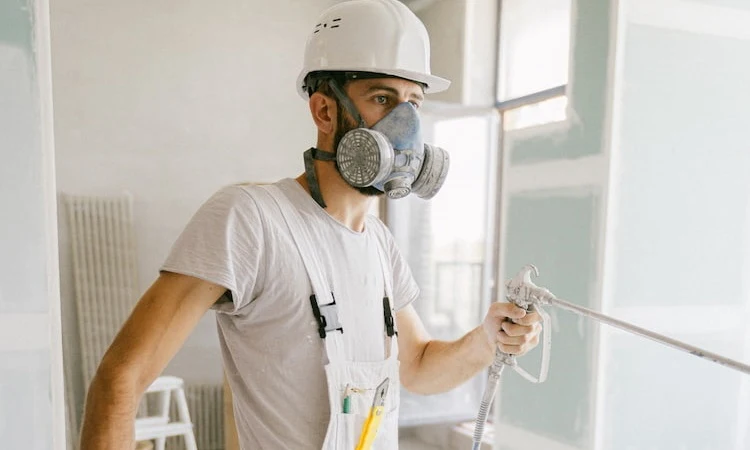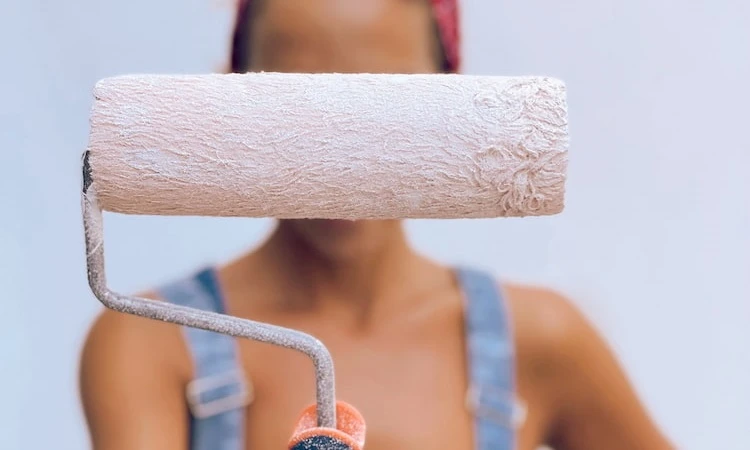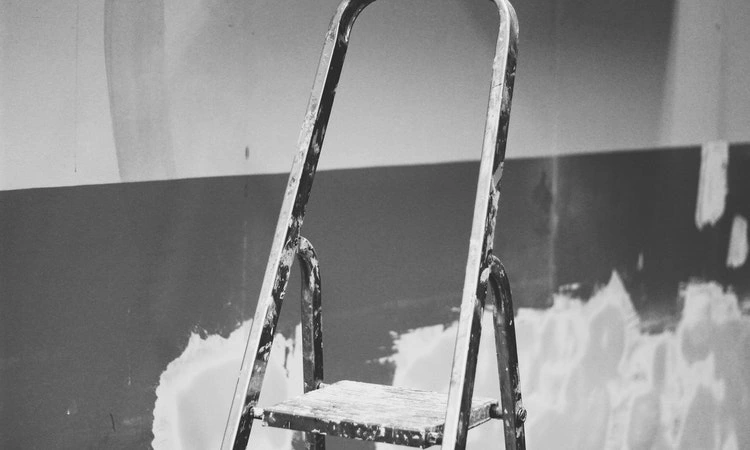Using a spray gun is a good way to speed up your painting job and ensure even coating.
However, if you are using water-based paint, it may not work without adding thinners. Therefore, the answer to the question “How to thin latex paint for sprayer?” is worth exploring.
You cannot thin latex paints using oil-based paint thinners. Solvents and water are not compatible; they don’t mix. As a result, paint ingredients will separate and create a mess. Instead, use a controlled amount of tap water until you obtain the level of thinness you desire.
If you are working on a big project and deal with buckets of paint, the thinning job could be challenging.
If there is no technical information on how to thin the paint, ensure that you measure the amount of water you mix with a particular volume of paint solution.

Why You Should Thin Paint When Using a Sprayer
The viscosity of the paint does not work well with spray guns. In other words, you need to thin the paint to get the best result.
The type of paint you are working with doesn’t matter. Water-based and oil-based paints need thinning, although the process may be different.
The paint is thick enough to pass through the nozzle of your spray gun if you don’t add a thinner. If you manage to spray it, the result will be ugly.
Therefore, you must thin the paint before loading it into your sprayer. Don’t waste your effort and resources by skipping the thinning process.
Product descriptions may say that the paint has no issue with spray guns, but you still need to thin the paint to obtain consistency during the application.
Forcing to spray an unthinned paint would also likely ruin your equipment as the thick solution will build up behind the gun’s trigger.
The type of sprayer you are also using matters when thinning paint. Airless sprayers can handle thicker paint mixtures better than other spray guns, such as HVLP and pneumatic sprayers.
So, if you are using HVLP, you might need to add a little extra thinner.
Can Latex Paint Be Thinned?
As I mentioned in the previous section, it is a must to thin the paint if you wish to apply it using a spray gun. Even if you deal with latex paint, you must do the process.
Of course, you can thin water-based paints like oil-based paints. However, you cannot use paint thinners as they are not compatible.
The basic material to use in thinning latex paint is water. The water mixes well with the paint solution.
To ensure that you do not destroy the integrity of the mixture, you should measure the water you are adding to the solution.
This step is helpful, especially if you deal with buckets of paint for a big project.
You need to use water to thin water-based paints because oil-based paint thinning solvents don’t work. These paint thinners will not mix with latex paint solution.
You will end up wasting your gallon of paint if you insist. Therefore, go with the basics by using water.
Other alternatives other than water include isopropyl alcohol and a concoction.
You can also use these to thin latex paints, but tap water is straightforward.
How to Thin Latex Paint for Sprayer
If you’ve reached this far in the article, it could mean you have a painting project, and you want to use a sprayer.
You must be excited and can’t wait to get started. But before you begin, let me give you the steps on how to thin water-based paints for you to succeed.
Tools to Use
- Paint strainer (ensures that the paint is clean before you load it to the sprayer)
- Paint stick (to stir the paint well)
- Funnel (to test the paint’s thickness)
- Liquid measuring cup (to ensure you are adding the correct amount of water)
- Water (alternatively, you can use isopropyl alcohol or a concoction)
- Bucket/cup (for stirring/mixing convenience)
Step 1: Check the paint requirement.
Check how much paint you need for the project. If you have a gallon, but your project will only use a quarter, don’t thin the entire can.
It is also important to measure the paint you will thin to determine the amount of water to add. See the next step.
Step 2: Calculate 10% of the total paint volume.
The ideal practice is to thin the paint by 10% in thinning paints. Generally, a gallon of paint requires 12-13 ounces of water to obtain the perfect thin.
You can use that as the basis for your formula.
Step 3: Pour the paint into a cup or a bucket.
It is best to pour the paint out of the can into a separate mixing container, such as a mixing cup or a bucket.
Step 4: Measure the water and pour it into the paint.
Based on your calculations, it is time to measure the amount of water to add.
Mix the 10% amount of water (of the paint’s actual volume) into the paint and start stirring.
Step 5: Stir and check.
After pouring the water, gently stir the paint solution using the paint stick for 8-10 minutes.
Again, you must not do this vigorously to avoid creating air bubbles in the paint. It would also help to pull the stirrer up from time to time to check the paint’s consistency.
Step 6: Check the paint’s thickness.
It is time to pick up your funnel and dip it into the paint to check its viscosity.
You will know that the mixture is ready for spraying when it flows freely from the end of the funnel.
If you notice that it is still thick, add a small amount of water and repeat the stirring.
However, you need to remember the 10% rule. If you need to add more water to obtain the thinness you desire, you must do it cautiously.
Step 7: Strain the paint.
To get rid of the impurities in the paint, such as clumps, dirt, dust, etc., strain the mixture.
Although this step is important, some people will skip this and directly load the paint mixture into the sprayer. However, I highly suggest that you do this.
Step 8: Start the fun.
Load your spray gun with the thinned paint. Ensure to follow the equipment manual regarding how much volume of solution you can load at a time.
Start the spraying job. Thinning the paint may cause the color to become lighter, so it is best to do multiple coatings to achieve the actual color quality.
What Other Items Can You Use to Thin Latex Paint Instead of Water?
The perfect match to thin latex paint is water. As the paint solution is water-based, water is 100% compatible.
However, if you wonder if there are other thinners you can use besides water, I will mention a couple below.
Isopropyl Alcohol
Isopropyl alcohol is a good alternative to thin latex paint.
Those who have tried using it as thinner recommends using 91% isopropyl, but a lesser count can be fine.
You probably wonder if isopropyl mixes with water. Well, you can stop wondering. It bonds with water and can function as a thinner.
If you want to know the steps of using isopropyl alcohol as thinner for latex paint, you can follow the steps above.
The thinning of water-based paint using isopropyl is the same when you use water.
However, you might need to observe extra precautions to avoid skin and eye contact.
Using a Concoction
Using a concoction or a mixture of various ingredients will also work.
You need a few elements, including dish soap, alcohol, and boiling water.
You can start by boiling 1.5 cups of water.
When the water boils, you can add 1.5 tablespoons of dish soap. Finally, add 1/2 cup of alcohol to the mixture.
When the concoction is ready, follow the thinning procedure above until you achieve your desired thinness of the paint.
As always, ensure that it completely mixes with the paint solution.
Also, do not skip the straining to remove all impurities before loading the mixture into your spray gun.
What Kind of Sprayer Do You Use for Latex Paint?
There are different kinds of paint sprayers available in the market, but the question is: which one should you choose to spray latex paint?
Should you use airless paint sprayers, pneumatic air sprayers, or high-volume pressure (HVLP)?
I highly suggest the use of airless paint sprayers. They are the best type to use when dealing with latex paint.
These sprayers can handle thicker solutions than compressed air or high volume low pressure (HVLP) sprayers.
Furthermore, it is also more capable of providing even surface coating.
Alternatively, you can consider using HVLP sprayers. However, you must ensure that the paint solution is thin enough to give you the best result.
These sprayers are also more expensive, so this may not be the best option if you are doing a small painting project.
You can also consider using pneumatic air sprayers if you already have a compressor. These types are less expensive than the first two types I mentioned above.
But these are the messiest of all the three types of sprayers.
Safety Tips to Follow when Thinning Latex Paint
Although you think that thinning latex paint is perfectly safe, it is still important to observe some precautions.
First, you need to ensure that you are not messing up the area where you conduct the thinning process.
Secondly, you must protect your health from the paint chemicals.
Below are some tips that you can apply when you thin latex paint:
- Wear gloves to avoid exposing your skin to the paint mixture. Although latex paint may be less toxic, skin contact may still cause some irritations.
- Wear goggles to protect your eyes. The paint fumes or the paint smell can be strong and cause some eye irritations. Prevent this from happening by wearing protective goggles.
- Put on that protective mask. Avoid inhaling paint fumes as much as possible. Avoid exposing your nose or throat to the paint, as you might inhale the toxins. The toxins you inhale may end up in your lungs, causing some health conditions.
- Thin your paint outside. Aside from the proper ventilation, doing the job outside also avoids mess. You don’t want to drop some paint on the floor or your furniture accidentally.
- Use the right tools to ensure accuracy and safety. I still remember my neighbor who used his finger to mix paint solution. Don’t follow him.
Related Read: How to Detox After Using Spray Paint?
Frequently Asked Questions
1. Can latex paint be diluted with water?
Water can dilute latex paint. Since latex paint is water-based, adding more water will not cause trouble with the paint’s composition.
However, you must ensure that you do not over-thin the paint. If you add more than the ideal amount of water, the paint mixture may completely lose its quality.
You can follow the common practice of thinning the paint by 10%. If you have a gallon of paint, the ideal amount of water to add is 12-13 ounces.
But you can add more water as needed until you achieve the level of viscosity that you desire.
The paint’s viscosity can be subjective. So, I would insist that you use a measuring cup to ensure that you will have control over the amount of water you are adding.
It is also useful to work on a big project that requires you to thin gallons of paint.
The color quality of the paint solution may be affected by the dilution. You might need to apply multiple coatings to obtain the paint’s actual or original color.
Using a single coat may appear lighter than the color of the unthinned paint.
2. Can you thin latex paint with alcohol?
Another alternative to thin latex paint is the use of alcohol.
However, not all types of alcohol may work—the kind of alcohol known to work perfectly in thinning water-based paints is isopropyl. But is this the best option? I don’t think so.
Thinning latex paint with isopropyl alcohol or other denatured alcohol may work, but it is not the top choice.
Using it may exacerbate the paint’s drying behavior and alter the paint solution’s compounds. Moreover, it can be a strong oxidizing agent.
Aside from the alcohol’s possible impact on the quality of the latex paint, it can also potentially cause health issues.
Skin contact may cause skin rashes, inching, redness, dryness, and other conditions. It is a hazardous substance. It would help if you avoided frequent or overexposure to isopropyl alcohol.
To ensure that the quality of the paint is not highly affected, I still recommend using ordinary water. It is less hazardous and more effective.
Water is all-natural; therefore, you don’t need to worry about any adverse effects. There are no chemical reactions involved.
3. Can you use paint thinner to thin latex paint for the sprayer?
The direct answer is NO. You cannot use paint thinner to thin latex paint because it is not compatible.
Paint thinner will not mix with water. Incorporating it into water-based paints will cause the paint ingredients to separate.
Thus, it will no longer work as intended, or the paint will become useless.
You might think of doing a little experiment, thinking it will work. It won’t work, so don’t attempt to experiment, even just for fun.
Water and oil don’t mix. You learned that from your chemistry classes, and we cannot break science. You cannot make it work.
Paint thinner thins oil-based paints perfectly. It is a perfect match if you are thinning oil-based paints.
However, you would also need to observe safety handling as this solvent may cause some irritations to your skin, eyes, and throat.
As for thinning your latex paint, stick with water or other options, such as isopropyl alcohol or a mixture of water, dish soap, and alcohol.
I highly recommend just using plain water. It is straightforward and safe. As long as you follow the proper thinning procedure, the result should be good.
Conclusion
Latex paint does not work well with sprayers without thinning. Although the container description may state that it is compatible with sprayers, you still need to thin the paint to obtain ease of application.
The paint solution is thick enough to pass through the spray gun’s nozzle.
It is best to use water to thin latex paint. The ideal amount of water to add is 10% of the total volume of paint to thin. Simply put, a gallon of paint requires 12-13 ounces of water.
Although it is a general rule of thumb, there might be an instance when you need to add a little more to achieve the thinness that will work with your sprayer.
You should never use paint thinners to thin latex paints. It just doesn’t work. These solvents are not compatible with water-based paints.
Instead of thinning the paint, they separate the paint ingredients and turn the solution into complete trash.
The best sprayer to use for latex paint is the airless sprayer.
This sprayer promotes even coating and can handle thicker paint solutions. It is also less expensive compared to HVLP sprayers.




